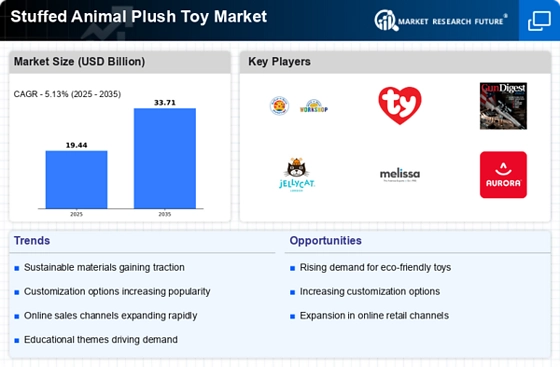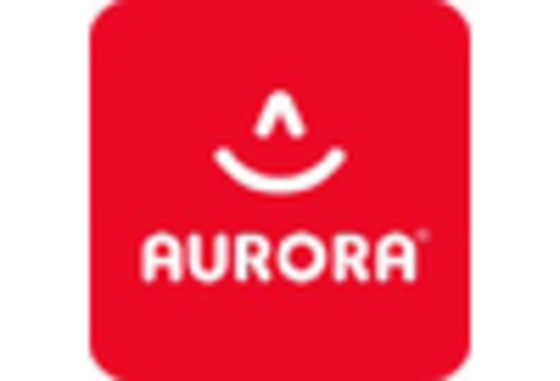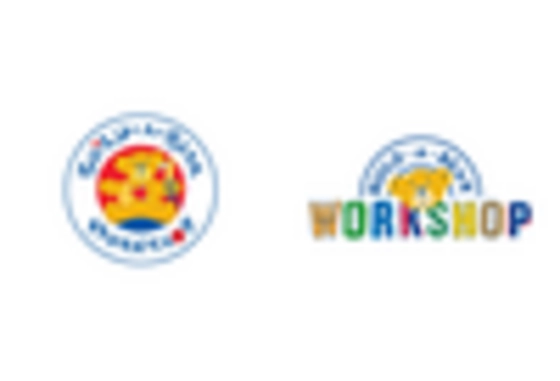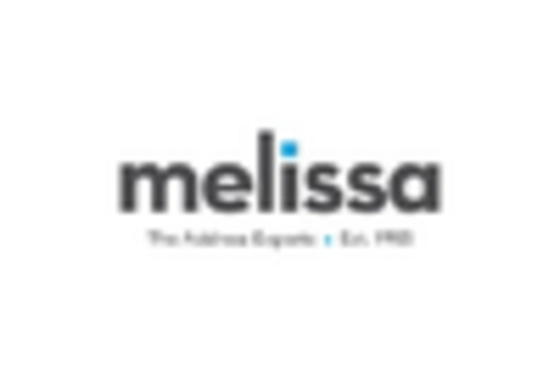The Stuffed Animal Plush Toy Market is currently characterized by a dynamic competitive landscape, driven by innovation, consumer preferences for personalized products, and a growing emphasis on sustainability. Major players such as Build-A-Bear Workshop (US), Ty Inc. (US), and Jellycat (GB) are strategically positioning themselves to capitalize on these trends. Build-A-Bear Workshop (US) focuses on enhancing customer engagement through experiential retail, while Ty Inc. (US) leverages its strong brand recognition and extensive distribution channels to maintain market share. Jellycat (GB), known for its unique designs, emphasizes product quality and creativity, which resonates well with consumers seeking distinctive plush toys. Collectively, these strategies contribute to a moderately fragmented market, where differentiation is key to gaining competitive advantage.
In terms of business tactics, companies are increasingly localizing manufacturing to reduce lead times and enhance supply chain efficiency. This approach not only mitigates risks associated with global supply chain disruptions but also aligns with consumer preferences for locally produced goods. The market structure remains moderately fragmented, with key players exerting considerable influence over pricing and product offerings. The collective actions of these companies shape a competitive environment where innovation and responsiveness to consumer trends are paramount.
In August 2025, Build-A-Bear Workshop (US) launched a new line of eco-friendly plush toys made from recycled materials. This initiative not only aligns with the growing consumer demand for sustainable products but also reinforces the company's commitment to environmental responsibility. By integrating sustainability into its product offerings, Build-A-Bear Workshop (US) positions itself as a leader in the eco-conscious segment of the market, potentially attracting a broader customer base.
In September 2025, Ty Inc. (US) announced a strategic partnership with a leading online retailer to enhance its e-commerce capabilities. This collaboration aims to streamline distribution and improve customer access to Ty's extensive range of plush toys. By focusing on digital transformation, Ty Inc. (US) seeks to adapt to changing consumer shopping behaviors, thereby solidifying its market presence in an increasingly digital landscape.
In July 2025, Jellycat (GB) expanded its product line to include a series of interactive plush toys that incorporate technology, such as sound and movement. This innovation reflects a growing trend towards integrating technology into traditional toys, appealing to tech-savvy consumers and enhancing play experiences. By diversifying its product offerings, Jellycat (GB) not only meets evolving consumer expectations but also differentiates itself in a competitive market.
As of October 2025, the Stuffed Animal Plush Toy Market is witnessing significant trends such as digitalization, sustainability, and the integration of artificial intelligence in product development. Strategic alliances among key players are increasingly shaping the competitive landscape, fostering innovation and collaboration. Looking ahead, it appears that competitive differentiation will evolve from traditional price-based competition to a focus on innovation, technological advancements, and supply chain reliability. Companies that successfully navigate these trends are likely to secure a competitive edge in the market.


















Leave a Comment